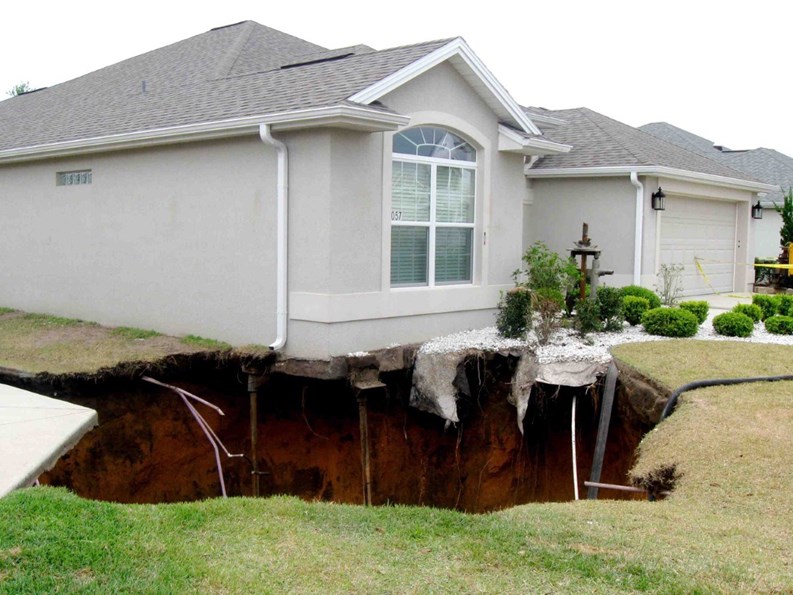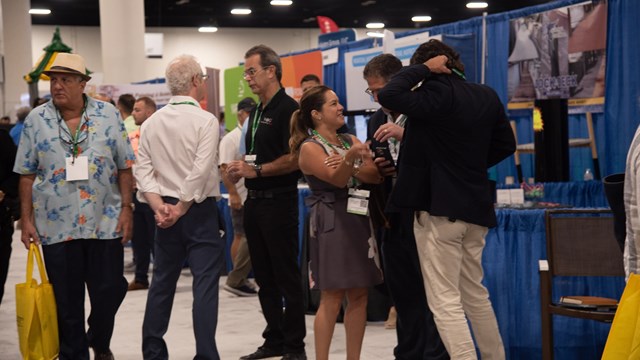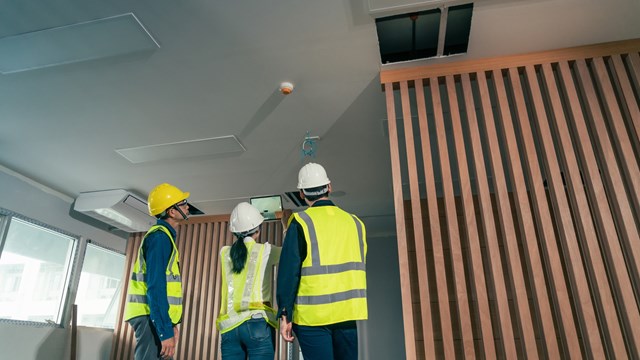It's a nightmare scenario; you're at home—maybe even sound asleep in your bed—or perhaps just walking down the street, and all of a sudden, the ground beneath you literally opens up, swallowing homes, cars, trees and even people into a muddy, seemingly bottomless pit. If you're in California, you might attribute such a catastrophe to an earthquake, but in Florida, chances are you've just witnessed—or been the victim of—a sinkhole. Some regions of the country are prone to sinkholes because of their geologic makeup—and Florida is one such region. Believe it or not, sinkholes are more of an insurance risk in the Sunshine State than hurricanes. And Florida has more sinkholes than any other state in the nation.
The Hole Story
The first thing you need to know about sinkholes is that there are two different kinds. The one where the ground opens up and houses fall in, like in a horror movie? That’s called a cover collapse sinkhole, and they are—thankfully—relatively rare. “The ground and the soil on the top totally gives way and collapses down into the hole,” explains Jay Silver, president of Helicon Property Restoration in Tampa. “Over time, the soil is eroding, and there’s a void close to the surface.”
The other—and by far more common—type is a subsidence sinkhole. “That’s down at the limestone layer,” Silver says. “Over time, as the rain progresses down through the soil, it becomes slightly acidic, and it will erode away that soft, porous limestone layer and cause it to bow down and dip, and the upper soils will slowly migrate downwards. This will cause a structure at the surface to experience some light settlement and some damage.” The most famous example is the sinkhole beneath the Leaning Tower of Pisa, which modern Italian engineers have managed to arrest…but not arrest so much that the wonder of the world loses its trademark tilt. Subsidence sinkholes can be shored up—or at least made more safe.
Why is this horror movie scenario so likely in Florida? It has to do with the state’s geological makeup—and its rapidly increasing population. There have been more than 300 sinkhole occurrences reported in Florida since 2010, and in one tragic 2013 incident, a man was killed when a sinkhole swallowed up the bedroom underneath his Tampa home.
“Almost all of Florida is susceptible to sinkholes to some extent, because the entire state is underlain by several thousand feet of carbonate rock, and carbonate rock is the collective term for limestone and dolostone,” says Clint Kromhout, a geologist with the Florida Geological Survey. “These are both dissolved by weak acids, which are found in both our groundwater and rainwater. The difficultly is knowing which areas are more conducive to dissolution than others. What we’re trying to do is map the geologies out and provide that map to the Division of Emergency Management and to others.”
If the geology makes Florida more prone to sinkholes, demographics only magnify the risk. “People are moving into areas that used to be farm fields with irrigation systems; they dredging and blasting in areas that they never would have expected to build on,” says Daniel Odess, president of Global Pro Recovery in Miami. “So we’re turning rural areas into urban ones, and that transformation is lending itself to a higher frequency of problems like sinkholes. So it’s no surprise that this is happening.”
I'm Fixing a Hole...
The damage from sinkholes to a piece of property is gradual—until it reaches the tipping point. They key of course is to avoid the catastrophic damage if at all possible.
“Walking the boundaries of your property is always a good idea,” says Kromhout. “That way you gain familiarity with the land. Take note of the topography and the vegetation, the built structures that are there. Keep a mental log of how things are oriented, like north, south, east or west, straight or crooked, etc. If you have a fence and in general the posts are straight up and down from ground surface, and then you start to notice that some of these posts are no longer pointing straight up, that might be an indication that there’s something going on below the surface.”
Kromhout isn't advocating alarmism, however; a crooked fence post may just mean that an animal has burrowed beneath it. “One singular observation is not enough to make a determination that something is associated with sinkhole activity,” he says. “It needs to be a collection of things. Let’s say that someone owns a piece of property and they start to notice that there’s an area that’s a little softer than other parts, and then over time that area starts to sink in, and maybe during rainstorms, water puddles there and then goes away. And then over more time, maybe the grass or bushes growing in that area start to show signs of stress or start to die.” That’s a telltale sign of sinkholes.
So say you do have a sinkhole on your property. How do you stop the problem from getting worse? “How that’s fixed is a compaction grounding service,” Silver says. “We’ll come around the whole perimeter of the structure and install four-foot sections of steel casing that are actually drilled down into the ground all the way to limestone through a method called mud rotary wash drilling. We inject high-pressure water down out of the bottom of the casing and at the bottom is a starter or a drill bit, a steel-cutter head that spins, and that’s what helps advance the injection point down through the soil layers. And once one four-foot section is installed, the operator will put in another pipe, thread it together, drill it down four more feet, and repeat that process until they hit the limestone layer where it’s being eroded.”
Then the engineer injects a specially-formulated grout mixture into the hollow areas. “The grout takes the path of least resistance, so it will cap and fill in all the voids in the limestone layer,” says Silver. “It’s like Swiss cheese—you’ve got a bunch of holes and crevices, and we’re capping it and sealing them. The grout is resistant to rain or water that will come down into the soil.”
The Politics of Holes
For a natural phenomenon, sinkholes have become a loaded political issue in many areas. Two recent state laws have legislated the relationship between homeowners and insurance carriers—and these laws, while well intended, may wind up having less desirable consequences.
“Florida Senate Bill 408 includes language allowing people buying insurance in Florida to opt out of sinkhole coverage,” Odess says. “Legislators believed that this would help reduce the cost of insurance, because the cost of sinkhole coverage was escalating.” This worked—although it may have just kicked the can further along the same road. “If you understand insurance from a policy holder’s perspective, by reducing the number of people that opt in, you decrease the pool of insurance. So it makes it harder to have payouts for sinkholes, because in Florida right now, sinkhole claims are more dangerous than any other type of claim for an insurance company, even more dangerous that hurricane claims.” As more and more homeowners opt out, the cost of their insurance goes down—but the risk of them having to foot the bill for massive sinkhole damage has increased.
“Sinkholes are typically covered by insurance, but that’s been changing with the new Florida Senate Bill 408 that was passed in 2011,” says Silver. “Now it’s next to impossible to get coverage. Our legislators were persuaded by the insurance companies, and it’s very bad for the general public right now, in terms of getting coverage for sinkhole damage.” And even the coverage you can get is hardly comprehensive; it’s closer in spirit to the dental coverage for root canals. “A property owner might have to pay 30 grand out of pocket for a $60,000 repair,” he says, “It’s not fair to make someone come up with 50 percent of the repair amount.”
This makes even fewer people opt in, which is terrible for rates. “If I’m a homeowner or property owner in this economic climate, and I have the ability to opt out and save myself a couple thousand dollars a year, I’m probably going to opt out,” he says. “And rather than talk about overpopulation and urban sprawl, our legislators are talking about the cost of sinkhole insurance to insurance companies.” themselves. And they’re blaming public adjusters and plaintiff’s attorneys rather than looking at all of these other factors.”
What is the recourse when sinkholes have been confirmed, and damage is done? “You want to notify your city or county building inspection department,” says Odess. “That’s your first course of action. And the sooner the better. The next thing to do is mar any depression on the ground with fencing, rope or tape to warn others of the danger, and protect them. Because you do have a trip and fall liability, just like if you have a slippery floor.”
If there’s property damage, and a claim might be filed, bring in the heavy guns. “The first thing is to call the insurance company and see if you have coverage,” says Silver. “Then you call the carrier to send out an adjuster to look at the physical damage. Once they verify the physical damage, they’re going to contract with and engineering geo-tech firm to do subsurface testing. Because without looking at what’s below the ground, you can’t determine if it’s definitely a sinkhole, or some other cause. And then they call a company like ours to put together an estimate and take care of the repair work that the engineer is recommending.”
If there’s a silver lining for condo owners, it’s that the grounds tend to be better inspected in residential housing complexes, both before and after construction. “Some of the larger apartment and condo buildings closer to the shore are built on pilings, so they dig down deep through the earth and they have to test the soils,” Odess says. “They do far more invasive testing than typically is done for a home, including geological studies.”
Right now, our knowledge of sinkholes is relatively primitive. But this is changing.
“With a hurricane, you can go out and just do a visual inspection of the damage but when it comes to sinkholes, you have to do destructive or invasive, or very costly ground-penetrating radar. Doing this for a single home could run over a hundred thousand dollars,” Odess says. “So our legislators are trying to determine how to deal with that expense, and the science behind it is a hot topic right now, just like mold used to be. Not that sinkholes are anything new, but the repair methodology we’re seeing right now, a lot of it is quite archaic. With earthquakes, it took years to figure out to make a building earthquake-resistant. But they accomplished it. And then with hurricanes they figured out how to build a roof that can survive a 200 mph wind. So I’m sure we’re on the cusp of having new technologies to predict and then prepare for sinkholes. Right now we’re having a hard enough time trying to just predict them.”
Greg Olear is a freelance writer and a frequent contributor to The South Florida Cooperator.







Leave a Comment